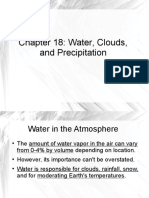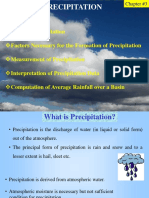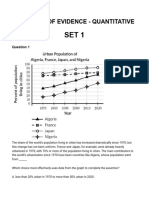100%(1)100% found this document useful (1 vote)
81 viewsHumidity
Humidity
Uploaded by
abhay kumarHumidity refers to the amount of water vapor in the air. It varies significantly and influences climate and weather. Humidity is measured using various scales and types. Water continuously cycles between the atmosphere, oceans, and land through processes like evaporation, condensation, and precipitation. When air reaches a level of saturation, water condenses and falls as precipitation in forms like rain, snow, or hail. The type of precipitation depends on atmospheric conditions.
Copyright:
© All Rights Reserved
Available Formats
Download as PPTX, PDF, TXT or read online from Scribd
Humidity
Humidity
Uploaded by
abhay kumar100%(1)100% found this document useful (1 vote)
81 views22 pagesHumidity refers to the amount of water vapor in the air. It varies significantly and influences climate and weather. Humidity is measured using various scales and types. Water continuously cycles between the atmosphere, oceans, and land through processes like evaporation, condensation, and precipitation. When air reaches a level of saturation, water condenses and falls as precipitation in forms like rain, snow, or hail. The type of precipitation depends on atmospheric conditions.
Copyright
© © All Rights Reserved
Available Formats
PPTX, PDF, TXT or read online from Scribd
Share this document
Did you find this document useful?
Is this content inappropriate?
Humidity refers to the amount of water vapor in the air. It varies significantly and influences climate and weather. Humidity is measured using various scales and types. Water continuously cycles between the atmosphere, oceans, and land through processes like evaporation, condensation, and precipitation. When air reaches a level of saturation, water condenses and falls as precipitation in forms like rain, snow, or hail. The type of precipitation depends on atmospheric conditions.
Copyright:
© All Rights Reserved
Available Formats
Download as PPTX, PDF, TXT or read online from Scribd
Download as pptx, pdf, or txt
100%(1)100% found this document useful (1 vote)
81 views22 pagesHumidity
Humidity
Uploaded by
abhay kumarHumidity refers to the amount of water vapor in the air. It varies significantly and influences climate and weather. Humidity is measured using various scales and types. Water continuously cycles between the atmosphere, oceans, and land through processes like evaporation, condensation, and precipitation. When air reaches a level of saturation, water condenses and falls as precipitation in forms like rain, snow, or hail. The type of precipitation depends on atmospheric conditions.
Copyright:
© All Rights Reserved
Available Formats
Download as PPTX, PDF, TXT or read online from Scribd
Download as pptx, pdf, or txt
You are on page 1of 22
Humidity
• Humidity, the amount of
water vapour in the air. It is
the most variable
characteristic of the
atmosphere and constitutes a
major factor in climate and
weather.
HUMIDITY
• Moisture continuously enters and leaves the atmosphere.
• When present in air, it gives air a different character.
• The process by which water vapour enters the atmosphere on heating
is knowns as evaporation.
• The process by which it again forms water droplets on cooling is
known as condensation.
• The process by which the droplets fall to ground in liquid ,solid or
frozen form is known as precipitation.
• The amount of water vapour present in air is known as humidity.
HUMIDITY
• The total volume of water in the • Vapour is the gaseous state of
oceans and seas is constant. water.
• This because all the water that • A certain amount of energy is
evaporates from the earth’s required to change water into water
water bodies is eventually vapour.
returned to it directly by the • Heating of water over oceans, lakes
process of condensation and and rivers causes water to
precipitation and indirectly by evaporates.
stream and overflow from land • Generally 600 calories of heat is
surfaces. required to change one gram of
liquid water into its vaporous state.
Factors Favoring evaporation
Types of humidity
HUMIDITY
Types of humidity
HUMIDITY
HUMIDITY
Types of humidity
MEASURING OF HUMIDITY
MEASURING OF HUMIDITY
CONDENSATION
• Condensation is the change of the physical state of matter from
the gas phase into the liquid phase, and is the reverse of
vaporization. The word most often refers to the water cycle. It
can also be defined as the change in the state of water vapor to
liquid water when in contact with a liquid or solid surface or
cloud condensation nuclei within the atmosphere. When the
transition happens from the gaseous phase into the solid phase
directly, the change is called deposition.
PRECIPATION
• In meteorology, precipitation is any product of the condensation of
atmospheric water vapor that falls under gravity from clouds.
• The main forms of precipitation include-
• drizzle, rain, sleet, snow, ice pellets, graupel and hail.
• Precipitation occurs when a portion of the atmosphere becomes
saturated with water vapor (reaching 100% relative humidity), so
that the water condenses and "precipitates" or falls.
• Thus, fog and mist are not precipitation but colloids, because the
water vapor does not condense sufficiently to precipitate.
FORMS OF PRECIPIATION
Types of rainfall
• Convectional Rainfall – Major Characteristics
• The air on getting heated becomes light and rises
in convection currents.
• As the air rises, it expands and drops the
temperature and subsequently, condensation
takes place and cumulus clouds are formed.
• Heavy rainfall with lightning and thunder takes
place which does not last long.
• Such rain is usually in the summer or the hotter
part of the day.
• This type of rainfall generally takes place in the
equatorial regions and internal parts of the
continents, predominantly in the northern
hemisphere.
• This rainfall is usually associated with hail and
graupel
TYPES OF RAINFALL
• Orographic Rainfall – Major Characteristics
• When the saturated air mass comes across a
mountain, it is forced to rise.
• The rising air expands, eventually, the
temperature falls, and the moisture gets
condensed.
• The principal characteristic of this type of rain is
that the windward slopes get more rainfall.
• After giving rain on the windward side, when
these winds reach the other slope, they drop
away, and their temperature increases. Then
their ability to take in moisture increases and
hence, these leeward slopes remain dry and
rainless.
• The region situated on the leeward side is known
as the rain-shadow area.
Types of Rainfall
• Cyclonic Rainfall – Major Characteristics
• Cyclonic activity causes cyclonic rain and it
occurs along the fronts of the cyclone.
• When two masses of air of unlike density,
temperature, and humidity meet then it is formed.
• The layer that separates them is known as the
front.
• A warm front and the cold front are the two parts
of the front.
• At the warm front, the warm lighter wind
increases slightly over the heavier cold air.
• As the warm air rises, it cools, and the moisture
present in it condenses to form clouds
• This rain falls gradually for a few hours to a few
days.
You might also like
- HYGE 220:hydrology and Hydrogeology: Lesson 1Document43 pagesHYGE 220:hydrology and Hydrogeology: Lesson 1UCHINDAMI NYONINo ratings yet
- Ncert Class11Document41 pagesNcert Class11Manoj SadanandamNo ratings yet
- Water Cycle 1Document12 pagesWater Cycle 1Uzair NaseerNo ratings yet
- Hydrological Cycle and Its ComponentsDocument18 pagesHydrological Cycle and Its ComponentsMaria LatifNo ratings yet
- Chapter 18: Water, Clouds, and PrecipitationDocument49 pagesChapter 18: Water, Clouds, and PrecipitationMd. Zd HasanNo ratings yet
- 8n. Moisture, Precipitation and Hydrologic CycleDocument22 pages8n. Moisture, Precipitation and Hydrologic CycleTirthadeep KunduNo ratings yet
- Lecture 2 Hydrological Cycle and Hydrological Budget EquationDocument19 pagesLecture 2 Hydrological Cycle and Hydrological Budget Equationaleezamalik487No ratings yet
- WATER CYCLE 2 - FDocument14 pagesWATER CYCLE 2 - FmgNo ratings yet
- Siklus AirDocument2 pagesSiklus AirmeyNo ratings yet
- Humidity and PrecipDocument60 pagesHumidity and PrecipA S Verma100% (1)
- Submitted By:-Satyapal Singh: Assistant Professor Baddi UniversityDocument17 pagesSubmitted By:-Satyapal Singh: Assistant Professor Baddi UniversitySamuel charlesNo ratings yet
- Air Moisture Part 1Document14 pagesAir Moisture Part 1hchanreiNo ratings yet
- CLIMATOLOGYNotesLecture11 PDFDocument8 pagesCLIMATOLOGYNotesLecture11 PDFRanjit kaurNo ratings yet
- Met OutlineDocument15 pagesMet OutlineShiloh Nicole AragonNo ratings yet
- Table of Content: - Powerpoint Presentation On Hydrologic Cycle - Leadership Profile On Azim Prem JiDocument6 pagesTable of Content: - Powerpoint Presentation On Hydrologic Cycle - Leadership Profile On Azim Prem JiKaran GuptaNo ratings yet
- Notes - Humidity - ICSE CLASS 10Document3 pagesNotes - Humidity - ICSE CLASS 10VeeNo ratings yet
- Rainfall Types Chapter 2Document70 pagesRainfall Types Chapter 2Avinash VasudeoNo ratings yet
- Presentaton on PrecipitationDocument15 pagesPresentaton on PrecipitationDeepak SinghNo ratings yet
- Cloud Development and Precipitation PresentationDocument109 pagesCloud Development and Precipitation Presentationpgnq52jpv9No ratings yet
- Hydrologic CycleDocument11 pagesHydrologic Cyclecarlafaith06No ratings yet
- Hydrology: The Flow of Water Across and Through Near Surface EnvironmentsDocument9 pagesHydrology: The Flow of Water Across and Through Near Surface EnvironmentsSN2-0620 Theeban Rau A/L ChanthiranNo ratings yet
- STD - 4 Air, Water and Weather - ppt1Document17 pagesSTD - 4 Air, Water and Weather - ppt1Manit ShahNo ratings yet
- Water On EarthDocument6 pagesWater On Earthnadamohey99No ratings yet
- Humidity & PrecipitationDocument15 pagesHumidity & PrecipitationShariya Abu NomanNo ratings yet
- Chapter - 2: Precipitation: ObjectivesDocument72 pagesChapter - 2: Precipitation: Objectivessiay mekonnenNo ratings yet
- Water CycleDocument65 pagesWater Cyclegracewrites4uNo ratings yet
- M1 CET307 - Ktunotes - inDocument32 pagesM1 CET307 - Ktunotes - insilambarasanNo ratings yet
- The Atmosphere Mechanisms of Heat Transfer Changes of State of WaterDocument26 pagesThe Atmosphere Mechanisms of Heat Transfer Changes of State of WaterKaren CotingjoNo ratings yet
- Weather and ClimateDocument5 pagesWeather and ClimateKaelyn MullinNo ratings yet
- Water and Atmospheric MoistureDocument29 pagesWater and Atmospheric MoisturesalcedocedmerkNo ratings yet
- Hydrologic Cycle and Water BudgetDocument29 pagesHydrologic Cycle and Water BudgetLarissa RiveraNo ratings yet
- Social Science - II, LESSON I, PART - 5Document12 pagesSocial Science - II, LESSON I, PART - 5Alpha OmegaNo ratings yet
- Environmental Cycles and ProcessesDocument32 pagesEnvironmental Cycles and ProcessesLeem harejNo ratings yet
- The Water Cycle 5Document1 pageThe Water Cycle 5api-269524162No ratings yet
- 3 CE 414 Precipitation TheoryDocument30 pages3 CE 414 Precipitation TheoryKhalid Khan100% (1)
- UntitledDocument13 pagesUntitledGian Carlo AquinoNo ratings yet
- HydrologyDocument5 pagesHydrologyPATRICEANNE CAISIPNo ratings yet
- Climate: Quarter 3 - Module 5-6Document30 pagesClimate: Quarter 3 - Module 5-6Joey ManasNo ratings yet
- Water CycleDocument10 pagesWater CycleBagongNo ratings yet
- Water CycleDocument17 pagesWater CyclenivanshisainiNo ratings yet
- Name: Date: Miss MoraytisDocument2 pagesName: Date: Miss Moraytisannamarie30No ratings yet
- THE-WATER-CYCLEDocument37 pagesTHE-WATER-CYCLEangelica.niebla05No ratings yet
- Physical Geography Chapter 11 PDFDocument10 pagesPhysical Geography Chapter 11 PDFVikas MarathaNo ratings yet
- MRI Formulas ConversionsDocument28 pagesMRI Formulas ConversionsKennethNo ratings yet
- 4.8 Hydrological CycleDocument17 pages4.8 Hydrological CycleBitto ThomasNo ratings yet
- Chapter 3 - Atmospheric WaterDocument40 pagesChapter 3 - Atmospheric WaterGabyNo ratings yet
- The Water CycleDocument14 pagesThe Water Cyclearme76No ratings yet
- Chemistry ProjectDocument6 pagesChemistry Projectharikcecaps14No ratings yet
- Weather SlidesDocument26 pagesWeather SlidesGraphic DesignerNo ratings yet
- ABEN 55 3 PrecipitationDocument63 pagesABEN 55 3 PrecipitationPEARL ANGELIE UMBANo ratings yet
- Physical Geography Chapter 11 HindiDocument14 pagesPhysical Geography Chapter 11 HindiVikas MarathaNo ratings yet
- EV 301 Engineering Hydrology Chapter 2: Precipitation: Dr. Ali SobhanmaneshDocument21 pagesEV 301 Engineering Hydrology Chapter 2: Precipitation: Dr. Ali SobhanmaneshLynas Beh TahanNo ratings yet
- Humidity, Condensation, and CloudsDocument42 pagesHumidity, Condensation, and CloudsEight Thousand100% (2)
- Water CycleDocument2 pagesWater CycleAnellah Ali100% (1)
- WeatherDocument16 pagesWeatherFrancis OdoomNo ratings yet
- Bahan Ajar Hidrologi DasarDocument103 pagesBahan Ajar Hidrologi DasarRizard LembataNo ratings yet
- Characteristics of The HydrosphereDocument1 pageCharacteristics of The HydrosphereOktavia DitaNo ratings yet
- Hydrological CycleDocument4 pagesHydrological CycleVincent JosephNo ratings yet
- Water CycleDocument13 pagesWater Cycleshees javedNo ratings yet
- Evaporation, Transpiration and Precipitation | Water Cycle for Kids | Children's Water BooksFrom EverandEvaporation, Transpiration and Precipitation | Water Cycle for Kids | Children's Water BooksNo ratings yet
- 3 AfterFishingWorksheetTeacher2Document3 pages3 AfterFishingWorksheetTeacher2Marie C0% (1)
- Vocab List HWWDocument1 pageVocab List HWWapi-238940794No ratings yet
- DistrictDocument7 pagesDistrictଶକ୍ତିପ୍ରସାଦ ମିଶ୍ରNo ratings yet
- Wonderfallfinal 2Document10 pagesWonderfallfinal 2api-273595156No ratings yet
- Pisciculture Pratisa Kar: Biology Investigatory ProjectDocument8 pagesPisciculture Pratisa Kar: Biology Investigatory ProjectPriyanshu Priyadarshi MeherNo ratings yet
- Lesson PlanDocument11 pagesLesson PlanJean AmocapNo ratings yet
- 4º Año - Trabajo Práctico Integrador de Inglés 2022Document3 pages4º Año - Trabajo Práctico Integrador de Inglés 2022belen PereiraNo ratings yet
- Kisi-Kisi Soal EnglishDocument2 pagesKisi-Kisi Soal EnglishDonieromanNo ratings yet
- Bahasa Inggris (Stop Ocean Plastic Pollution) TRI YULIANA TKL CDocument2 pagesBahasa Inggris (Stop Ocean Plastic Pollution) TRI YULIANA TKL CMaryantiNo ratings yet
- Raz Le20 ShapestidepoolDocument16 pagesRaz Le20 ShapestidepoolPhuong Anh HaNo ratings yet
- Essay On Climate ChangeDocument3 pagesEssay On Climate ChangeAshley GooljarNo ratings yet
- Digital Sat Reading & Writing - Command of Evidence QuantitativeDocument16 pagesDigital Sat Reading & Writing - Command of Evidence Quantitativethanh.ngo50% (2)
- The Melting of Floating Ice Raises The Ocean Level: Peter D. Noerdlinger and Kay R. BrowerDocument6 pagesThe Melting of Floating Ice Raises The Ocean Level: Peter D. Noerdlinger and Kay R. BrowerAnonymous UnceXTc1No ratings yet
- Sea Water IntrusionDocument9 pagesSea Water IntrusionJafarsadik SaiksanadiNo ratings yet
- This Study Resource Was: Jerome AngelesDocument5 pagesThis Study Resource Was: Jerome AngelesHugsNo ratings yet
- Smart Notes On Indian Geography: Point. Precise. PowerfulDocument102 pagesSmart Notes On Indian Geography: Point. Precise. PowerfulShivraj R B100% (1)
- Index - Atpl Campus 1Document60 pagesIndex - Atpl Campus 1pokerface747No ratings yet
- Ram SetuDocument2 pagesRam Setumitali_4567100% (3)
- Bahrain To Study Risks of Climate Change On Marine EnvironmentDocument2 pagesBahrain To Study Risks of Climate Change On Marine EnvironmentZainab MukhtarNo ratings yet
- Effective Wind Speed: Standard MethodDocument1 pageEffective Wind Speed: Standard MethodLaurence SarmientoNo ratings yet
- Climate and WeatherDocument31 pagesClimate and WeatherKamran AbdullahNo ratings yet
- Hydrographic - Surveying - PDH Farrell-1 PDFDocument38 pagesHydrographic - Surveying - PDH Farrell-1 PDFRaditya Nur RahmanNo ratings yet
- Atmospheric StabilityDocument19 pagesAtmospheric StabilityHemraj BairwaNo ratings yet
- Life Below Water:: Why It MattersDocument2 pagesLife Below Water:: Why It MattersMonica AttiaNo ratings yet
- What Is Law of The SeaDocument8 pagesWhat Is Law of The SeaTanisha sighalNo ratings yet
- Weather - Pressure and Air MovementsDocument2 pagesWeather - Pressure and Air MovementsSal CastronovoNo ratings yet
- Awp SigwxDocument2 pagesAwp Sigwxc_poliNo ratings yet
- Sea Floor Spreading ReadingDocument4 pagesSea Floor Spreading Readingapi-506851645No ratings yet
- Technical Report BalsaDocument8 pagesTechnical Report BalsaVianney Anthony Abella GapuzNo ratings yet
- Hydrology and Water Resources2Document38 pagesHydrology and Water Resources2Hazem AlmasryNo ratings yet

























































































